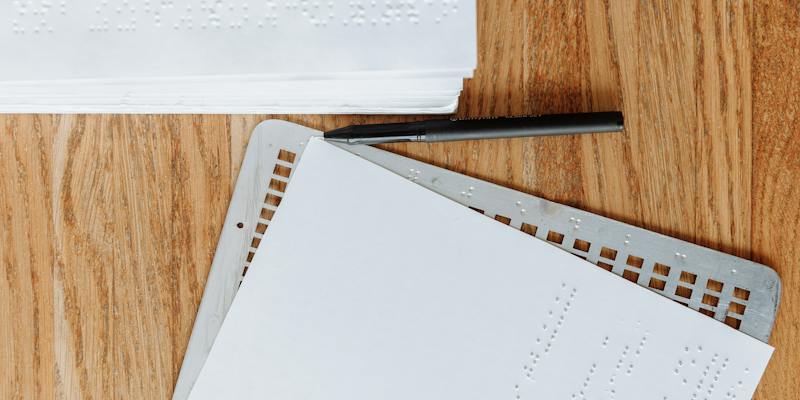In a groundbreaking development that showcases the power of artificial intelligence, researchers at the University of Cambridge have successfully built a robotic sensor that can read Braille at an astonishing speed. With the ability to decipher Braille text lines at a rate twice as fast as the majority of human readers, this innovation holds immense potential for the creation of future prosthetics and robotic hands. Braille, being a system that demands great sensitivity to differentiate the closely spaced dots, serves as the perfect testbed for developing more human-like robotic appendages.
Description of the University of Cambridge Research Team’s Work
Driven by the goal of replicating the exceptional reading ability of human fingers, the research team at the University of Cambridge employed cutting-edge machine learning methods to train a robotic sensor. This sensor swiftly glides over Braille text lines, analyzing and processing the information with remarkable speed and accuracy. In fact, the robot demonstrated an impressive reading speed of 315 words per minute, coupled with an accuracy rate of over 90%.
Significance of the Robotic Sensor in Prosthetic Development
The researchers firmly believe that the sensitivity required to read Braille serves as a litmus test for the creation of highly-sensitive prosthetics and robot hands. The human finger, with its extraordinary ability to absorb and comprehend information, has long been a goal for researchers aiming to develop prosthetics that truly replicate the capabilities of our natural limbs. By achieving a level of precision and speed comparable to human readers, this robotic sensor represents a significant step forward in bridging the gap between human and robotic dexterity.
Comparison of Human Fingers and Robotic Hands
One of the major challenges in replicating human-like sensitivity in robotic hands lies in engineering mechanisms that can match the softness and sensitivity of human fingertips. Our fingers possess an exquisite softness that allows us to apply the perfect amount of pressure when gripping objects. Replicating this degree of tactility while ensuring energy efficiency poses a significant engineering hurdle. Researchers at Professor Fumiya Iida’s group within Cambridge’s Department of Engineering are currently addressing these challenges and developing solutions for skills that humans find simple, yet remain difficult for robots.
Current Research and Solutions at Professor Fumiya Iida’s Group
Professor Iida’s team is relentlessly working towards finding innovative answers to the complex engineering problems associated with recreating human-like sensitivity in robotic hands. Their research initiatives span a wide range of disciplines, including material science, robotics, and artificial intelligence. By leveraging advancements in these fields, the team aims to overcome hurdles surrounding energy efficiency, grip, and optimal pressure for robotic hands. Their findings hold substantial promise not only for prosthetics but also for industries such as manufacturing and healthcare.
The Importance of Softness in Human Fingertips
The remarkable ability of human fingertips to grip objects with precision comes down to their innate softness. This softness enables us to effectively perceive the texture, shape, and weight of the object. When gripping something delicate, we instinctively adjust our pressure to prevent damage. Replicating this level of control and dexterity in robotic hands is crucial for applications in fields such as performing delicate surgical procedures or handling fragile and valuable objects.
Testing the robotic sensor’s capability using Braille
Braille, with its dense arrangement of dots in each letter pattern, provides an ideal testing ground for the robotic sensor’s capability to mimic a human fingertip. The need for precision in differentiating the dots and their arrangement ensures that the robotic sensor is pushed to its limits, gauging its effectiveness in emulating human reading behavior. By achieving exceptional speed and accuracy in Braille reading, the researchers demonstrate the capability of their technology to capture intricate details present in human touch.
Utilization of Off-the-Shelf Sensors in the Robotic Braille Reader
To develop the robotic braille reader, the researchers incorporated off-the-shelf sensors, enhancing the device’s ability to mimic human reading behavior more closely. This approach allows for cost-effective and efficient development, bringing the technology closer to practical applications and potential commercialization. By utilizing existing technology, the research team has opened avenues for further exploration and innovation in the realm of robotic sensory systems.
The development of a robotic sensor that can read Braille at unparalleled speeds reflects the significant strides made in the field of artificial intelligence and robotics. With a reading speed of 315 words per minute and an accuracy rate exceeding 90%, the potential applications of this technology are immense. By addressing the challenge of replicating human-like sensitivity in prosthetics and robotic hands, the University of Cambridge research team has paved the way for a future where such devices can provide individuals with enhanced dexterity and a greater sense of touch. As their work progresses, it is evident that these innovations will continue to redefine the boundaries between humans and machines, bringing us closer to a world where robotic companions and prosthetics are seamlessly integrated into our lives.

